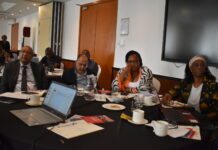
By Winnie Kamau, Mose Mogeni and Fred Deya

Peter Ojung’a discovered his HIV status 17 years ago, through what he terms as betrayal by his lover. Ojung’a takes us through his ordeal that is filled with a lot of turmoil heartache and pain. A life that he has gradually come to accept as God’s will.
Ojung’a’s ordeal started in the year 2000 when he visited a public hospital in Mombasa County to pick his wife who had just delivered his first born daughter. He was accompanied by his father in-law during the visit and both were anxiously waiting to see the newborn baby.
While waiting outside, a nurse ushered them into the delivery ward where they found the newborn baby happily bonding with the mother. Just before they were released, the nurse asked who the father of the baby was, to which Ojung’a responded with a lot of confidence, “I’m the father of the baby.” Though a joyous moment the nurse still gave Ojung’a a troubled look.
Haunted by the nurse’s look two weeks later, Ojung’a decided to go back to the hospital in search of answers; unknown to him the answers would change the course of his life in a dantean way. Luckily, he found her and he inquired what the look meant as he explained he felt troubled. It is at this point in time, that the nurse gave him the shocking news of his wife’s HIV status.
Facts on HIV/AIDS Spending in Kenya looking at the 1.5 million Kenyans living with HIV/AIDS. Interesting facts reveal government has not been spending as much as they have been saying in the fight against scourge. However there’s been an increase in the uptake of Antiretroviral Treatment (ART)
Ojung’a describes this shocking moment with a forlorn look. The nurse explained that they discovered his wife was HIV positive while attending prenatal clinics “We were just wondering how to inform him that day since she wasn’t so sure if she had already told you” This tore Ojung’a apart as all he could recall was that before their wedding they had gone for tests and each presented their certificates to each other and they were both negative.

Ojung’a is one of the 900,000 Kenyans who is currently under antiretroviral treatment (ART) and as he continues with his crusade in secondary schools using his book to sensitize the youth through Art and Music he is urging them to know their HIV status.
But this is not so for the 15% of Kenyans living in the capital, Nairobi who are dying undiagnosed of their HIV status a recent Mortuary Surveillance Report shows. According to the report released by the National AIDS agency NASCOP it conducted the study in the two public mortuaries in Nairobi – Kenyatta National Hospital and City Mortuary. The study showed 3 out of 4 people who died out of HIV never knew their status.
The Ministry of Health is raising a red flag citing many Kenyans are walking with undiagnosed HIV/AIDs with most seeking treatment in hospitals for different complications without knowing that HIV is the underlying cause of their current problems.
According to the Kenya Aids Response Progress Report of 2014, 9 out of 100 people aged between 15-64 yrs in Nairobi are HIV+. The study also indicated that In every 100 Nairobians aged 25-45 yrs old, 67 of them were most affected by HIV/Aids in 2014 and this is attributed to Stigma according to the Ministry of Health. United Nations Agency on AIDS (UNAIDS) pitts Kenya’s population affected by HIV at 1.5 million people with the Counties in the Western Region having the highest prevalence rates according to the Counties HIV Prevalence rates.
Permanent Secretary at the Ministry of Health, Dr. Nicholas Muraguri noted with a lot of concern that this was a wake up call for the country as there are many people who are sexually active and yet they don’t know their status “We need to scale up our testing campaign to test the increasing number of sexually active people. This is a wake up call for us, as the number of people walking with undiagnosed HIV is so high”
Muraguri was speaking at the recent launch of HIV campaign carried out by the government through the National AIDS Agency – Anza Sasa campaign has made it mandatory for everyone with HIV to undergo ARTs. The International guidelines indicate that people who are treated early with HIV are less likely to fall sick, they live long and are less likely to transmit the disease to their partners. Pundits say this is part of the bigger HIV strategy of a HIV free society by 2030 in Kenya.

But what raises the eyebrow is the amount spent by the Government in the fight to eradicate HIV. According to research, Kenya Government spent 58 Billion Shillings between 2006-2013 on HIV/AIDS prevention, which is an average of 8 billion annually. However, in 2008/2009 and 2012/2013 the government spent below 2 billion shillings contrary to what Dr. Muraguri had cited that every year up to 20 Billion Shillings is spent to ensure that people can access ARTs. A trend revealing that in every election year the monies allocated for HIV are slashed, this begs the question what happens during the budgets of election years.
In a recent visit by the Prime Minister of India Narendra Modi formed a partnership that will see an increase of locally manufactured drugs as most of the ARTs are imported from India. NASCOP Director Dr. Jackson Kioko noted that the Anza Sasa campaign would be able to capture Data of the many people who are not tested “The Anza Sasa campaign will be able to know the magnitude of people we will reach who do not know their status.”
The Ministry of Health, says 900,000 Kenyans are on treatment and it takes 15,000 shillings(150 USD) to keep one person alive per year. This translates to 13.5 Billion Shillings spent annually with the help of both government and donor funding. The over dependence on donor funding has been a major concern but the government defended itself saying a fire exit strategy has been developed whereby the government will take up this costs. At the moment 6.2 million Kenyans are insured by National Hospital Insurance Fund (NHIF) and the government expects NHIF will take up this costs.















“Many Kenyans are walking with undiagnosed HIV/AIDs with most seeking treatment in hospitals for different complications without knowing that HIV is the underlying cause of their current problems.” The earlier one knows the better…strategies should be put in place to ensure that these trend is reversed.
Comments are closed.